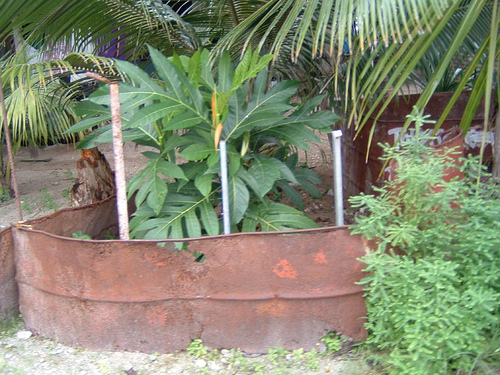- Concentrating management practices on conserving a particular plant species may have bad consequences for other bits of biodiversity. Lessons for crops wild relatives?
- Benin’s farmers ennoble wild yams.
- A Lebanese lunch is an educational experience. Right.
- Paddyomics video. Nothing to do with the Irish. It’s about how IRRI is automating, er, everything about its phenotyping.
- Tamarind’s environmental niche is, in fact, er, niches?
- Different wheat genomes generate distinct protein profiles.
- Phylogenetic relationships of a new Mediterranean lupin.
- Betel nut chewing endangers coral. Kinda. Traditional and all that, but an unpleasant habit nonetheless.
- Our friend Bhuwon and others tell the story of the participatory improvement and formal release of Jethobudho rice landrace in Nepal.
- CGIAR elicits comment on the Agriculture for Improved Nutrition and Health megaprogramme. Until August 1.
- Bacterial diversity boosts maize yields.
Ripe breadfruit blown from a tree in a storm
The final paragraph of The Economist’s obituary of Mau Piailug, Pacific navigator and culture hero:
In 2007 the people of Hawaii gave him a present of a double-hulled canoe, the Alingano Maisu. Maisu means “ripe breadfruit blown from a tree in a storm”, which anyone may eat. The breadfruit was Mau’s favourite tree anyway: tall and light, with a twisty grain excellent for boat-building, sticky latex for caulking, and big starchy fruit which, fermented, made the ideal food for an ocean voyage. But maisu also referred to easy, communal sharing of something good: like the knowledge of how to sail for weeks out on the Pacific, without maps, going by the stars.
And like plant genetic resources, including breadfruit, perhaps. Anyway, a good word to know, maisu. Pacific people really take care of their breadfruit trees, incidentally. I took this photo in Kiribati a few years back.

Nixing agrobiodiversity?
Richard Jonasse at Food First did a reasonable job a few days ago of rehearsing the old WEMA vs LEISA (let’s call it) dichotomy in agricultural development. He’s done it before, and so have we, 1 and I won’t go on any more about that. But I did want to say something about one of his assertions. In talking about the policies of USAID and the Gates Foundation, Jonasse says:
What these policies do not do is directly end African hunger by strengthening Africa’s farmers where they stand. This point was underscored recently when, after the Gates Foundation donated $270m (with a promise of $1Bn over the next few years) to CGIAR, Gates’ representatives nixed CGIAR’s agricultural biodiversity mega-programme, saying it was “unfocussed.” This logic represents precisely what is wrong with the Gates/USAID approach. Only an “unfocussed” low-tech approach that honors biological and cultural diversity is likely to be successful in Africa.
Well, that may well be, but the SciDevNet piece to which he links to support that “unfocussed” comment by a “Gates’ representative” doesn’t do that at all. What “Prabhu Pingali, deputy director of agricultural policy and statistics at the Gates Foundation, told the Global Conference for Agricultural Research Development (GCARD) (28—31 March)” is that the megapgrogrammes, as then constituted, “[b]ecause they are so fuzzy … are not likely to generate enthusiasm for increased funding.” All the megaprogrammes, note, not just the agricultural biodiversity one. The agrobiodiversity megaprogramme was indeed “nixed,” but I can find no comment by a Gates Foundation rep on it, either for or against. And anyway, everything still seems to be up in the air on these megaprogrammes. You can follow the CGIAR’s change process on their website and blog.
Nibbles: Cassava virus, Peru’s Potato Park, Marula, Taimen, Meetings, Cornish fruits and veg
- New cassava varieties saving Zanzibar. Good to hear, though as ever one worries about what’s happened to the local landraces.
- Alder’s photos of the Potato Park. Do follow her travels around South America in search of agrobiodiversity.
- Namibia looks for other marula products.
- Saving the taimen in Mongolia. That would be a fish. A mighty fish.
- Interesting Indian symposia: wild fruits; “lifestyle floriculture.” Oh, to have more information.
- “Gariguette strawberries are an old variety and are non-licensed.” Crazy, eh?
Nibble: Conservation ag, Sahelian famines, Homegarden fertility, Annals of Botany news roundup, Carrot geneflow, Cyanide in crops, Texas rice breeding
- “…conservation tillage in Europe may indeed have some negative effect on yields, [but] these effects can be expected to be limited: the overall average reduction we found was ca. 4.5%.” Well I guess it’s good to have the data.
- Today’s solution for the Niger famine is fertilizer micro-dosing. I kid you not. But you should read that first link.
- Homegardens good for soil fertility. Well I guess it’s good to have the data.
- Nigel Chaffey’s Plant Cuttings. Priceless.
- “High outcrossing and long-distance pollen dispersal suggest high frequency of transgene flow might occur from cultivated to wild carrots and that they could easily spread within and between populations.” Transgenic carrots? Well I guess it’s good to have the data.
- Kenneth Olsen interviewed on cyanide in plants. Nice enough, but you read about this stuff here first.
- “Rice breeders seek yield advantage.” Do they now.